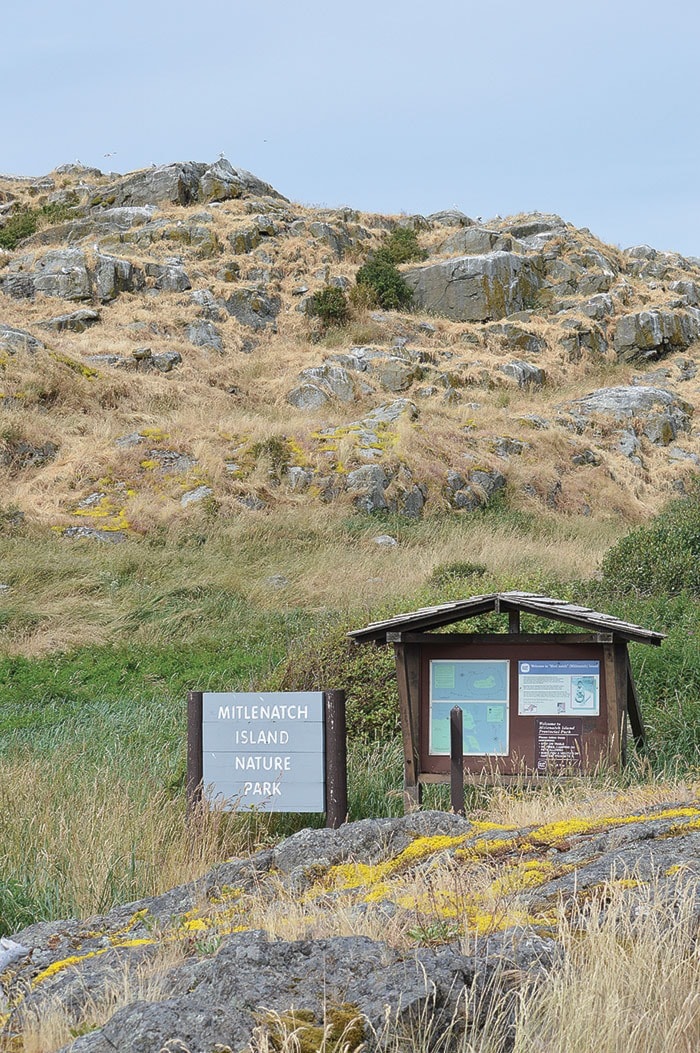Sitting in the middle of the northern Strait of Georgia lies B.C.’s own “desert island” – Mitlenatch.
It’s not actually a desert but it does have a climate that supports cactus. Because it lies in the rain shadow of Vancouver Island’s mountainous spine, Mitlenatch receives less than half the rainfall that Campbell River does. Consequently, it’s a dry oasis more like the Interior of British Columbia than the surrounding rain-forested shores, mountains and islands.
Despite the unique climate, what sets Mitlenatch apart even more is the birds. Thousands of them congregate on the island to nest and lay their eggs. It’s for that reason the island has been set apart as a provincial park nature preserve. And if you plan to visit the island, you need to be aware that there are rules and guidelines to be followed that protect the delicate island habitat.
“What we want the public to know about Mitlenatch Island is that, first of all, they’re very welcome and they’re encouraged to come over here, it’s a beautiful place to spend the afternoon,” says Don Griffiths, a volunteer with Mitlenatch Island Stewardship Team (MIST), a group of volunteers who each spend a week living on the island from April to September acting as interpreters, park wardens and field researchers. “Because it’s a bird colony, there are a couple of rules and one is there are no pets (allowed) on the island.”
People often have a dog with them in their boats and the animal needs to relieve itself, so the owners will take them ashore on Mitlenatch and let them run around. And dogs and birds don’t mix, Griffiths says.
Another rule about visiting the island is that it is a very fragile ecosystem. The dryness means that the vegetation is delicate and struggling to survive. In the low-lying centre of the island where people usually land, there is a fragile area called the meadows that’s accessible from the beach.
“The meadow is very fragile…so we ask people to stay on the trails,” Griffiths says.
From the meadows, you can access a bird blind that allows visitors to observe the nesting birds.
“They’re encouraged to go up there and spend time with the birds, it’s very nice. You can sit there with the birds right at your feet,” Griffiths says. “It’s a wonderful place to be without disturbing the birds.”
The birds know you are in the blind and so you are asked to be quiet
“You do need to be quiet and not wave around and yell.”
You’re especially asked not to stick your finger out the front of the blind to point, it disturbs the birds.
“Just common sense,” Griffiths says about the guidelines on visiting the island.
There’s a sign that says “please wait down here” when you approach the bird blind. It only holds about four people so you’re encouraged to wait to enter it after people have left.
Move completely quietly up into the bird blind. You can talk quietly in the bird blind.
Another area of concern around the island is the resident sea mammals. Sea lions are common, particularly in the spring.
“A month ago, there was a hundred of them on an island here,” Griffiths says.
In the fall and winter, there are sea lions on the island all the time.
“They’re probably the tamest sea lions on the coast,” Griffiths quips.
“But marine regulations say you are to stay 100 metres away from sea lions and we see a lot of bad boating behaviour around in terms of the sea lions. People banging right up on the rocks below them, pushing them in the water.
The sea lions get pushed in the water and they use a lot of energy getting out and too much harassment can actually destroy the colony. This is one of the main challenges we have early in the season here is dealing with people’s bad behaviour around the sea lions.”
Regulations say stay 100 metres way but bring your binoculars and you will have a fantastic view of them, Griffiths says.
If you learn how to behave around sea lions not gunning your engine just drifting sideways by them, not looking them in the eye, you’ll be able to watch these magnificent animals without disturbing them.
“Most of the public is trying to behave well, but if you see them (the sea lions) up and looking at you, you’re probably starting to disturb them,” Griffiths says.
Another thing to be aware of about Mitlenatch Island is that the waters around it have recently been declared a rockfish conservation area. There is no fishing whatsoever within the rockfish conservation area. That includes salmon fishing.
The size of the conservation area is quite big.
Griffiths’ rule of thumb about that is “you should be closer to somewhere else than you are to Mitlenatch to be outside that area.”
The conservation area runs about half way to Quadra Island, halfway to Hernando Island and halfway to Vancouver Island. Then the same distance toward the south into the Strait of Georgia.
Griffiths acknowledges that there’s not many closed areas so its often a surprise to anglers that they’re in a closed area.
The MIST volunteers are there to inform people about the rules, sometimes that involves getting out a bullhorn
“I had a guy last night fishing right off F island. I had a bullhorn and I said ‘hello sir!’” Griffiths says. “I said Mitlenatch Island is a a no-fishing zone. We’re a rockfish conservation area.”
The boaters reeled in their lines and left.
“I think most people want to follow the rules,” Griffiths said. “We just tell them what the rules are.”
There are many delightful things to see on and around Mitlenatch Island, you’re just asked to treat it with respect and in a way that doesn’t disturb the flora and fauna.
